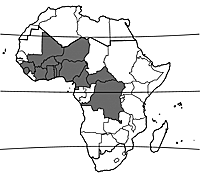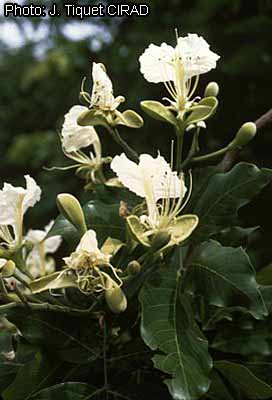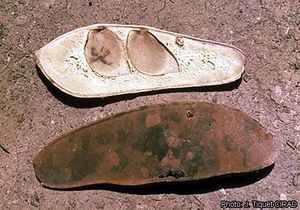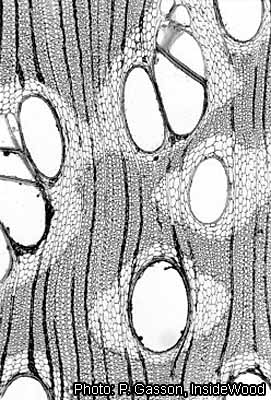Berlinia grandiflora (PROTA)
Introduction |
| General importance | |
| Geographic coverage Africa | |
| Geographic coverage World | |
| Medicinal | |
| Timber | |
| Ornamental | |
| Forage / feed | |
| Auxiliary plant | |
Berlinia grandiflora (Vahl) Hutch. & Dalziel
- Protologue: Bull. Misc. Inform. Kew 1928(10): 398 (1928).
- Family: Caesalpiniaceae (Leguminosae - Caesalpinioideae)
- Chromosome number: n = 12
Synonyms
- Berlinia acuminata Sol. ex Hook.f. (1849),
- Berlinia heudelotiana Baill. (1865).
Vernacular names
- Melegba des galeries (Fr).
Origin and geographic distribution
Berlinia grandiflora is widespread from Guinea and Mali east to the Central African Republic, and south to DR Congo.
Uses
The wood is used for construction in house building, planks, flooring, joinery and food containers. It is suitable for interior trim, ship building, vehicle bodies, furniture, cabinet making, railway sleepers, stakes, draining boards, turnery, veneer and plywood.
Bark sap is applied to sores and wounds, and bark decoctions are administered to treat haemorrhoids and liver complaints, and as a vermifuge. A decoction of leafy twigs is used as febrifuge, cholagogue and anti-emetic; however, it is also reported to be used as emetic and purgative. Leaf decoctions are taken as a tonic.
Berlinia grandiflora is sometimes planted as ornamental tree and shade tree in villages, and as a shade tree in coffee plantations. It is occasionally browsed by livestock, especially sheep and goats.
Production and international trade
The wood of Berlinia grandiflora is mainly used locally and rarely traded on the international market as ‘melegba’.
Properties
The heartwood is pinkish brown to reddish brown with purplish streaks, and distinctly demarcated from the pinkish white, wide sapwood. The grain is interlocked, texture medium to coarse. The wood is odourless and tasteless when dry.
The wood is medium-weight to moderately heavy, with a density of 690–820 kg/m³ at 12% moisture content. It air dries rather slowly but well, with occasionally slight distortion. The rates of shrinkage are rather high, from green to oven dry 5.9–6.0% radial and 8.5–10.4% tangential. At 12% moisture content, the modulus of rupture is 110–180 N/mm², modulus of elasticity 10,780–12,350 N/mm², compression parallel to grain 51–73 N/mm², shear 11–15 N/mm², cleavage 12–18 N/mm, Janka side hardness 6050 N and Chalais-Meudon side hardness 3.6–6.7.
The wood works and saws moderately well, but occasionally rapid blunting of saw teeth and cutting edges may occur. Picking-up of grain at planed surfaces can be problematic. The nailing and screwing properties are satisfactory, as well as gluing and bending characteristics. The staining and polishing properties are reportedly variable. The wood is moderately durable, being moderately resistant to termite attacks, but liable to pinhole and marine borer attacks. The sapwood is easily treated with preservatives, but the heartwood is resistant.
In bark extracts, the presence of alkaloids, tannins, flavonoids, triterpenes and glycosides has been demonstrated. Methanolic bark extracts showed acute toxicity in mice, with a LD50 of 37 mg/kg using intraperitonial injection. They significantly increased pentobarbitone-induced sleeping time in mice and showed analgesic effect. They induced a dose-dependent contraction of isolated guinea-pig ileum. Bark extracts showed anthelmintic activity in rats infected with Nippostrongylus brasiliensis and against the free-living soil nematode Caenorhabditis elegans. Betulinic acid was identified as active component.
Description
- Small to medium-sized tree up to 25(–30) m tall; bole often short, often irregular, sometimes straight and cylindrical, up to 50(–70) cm in diameter, without buttresses; bark surface scaly, dark grey to brown, inner bark pale brown to reddish brown, sometimes exuding a yellowish resin; crown rounded, dense, with spreading branches; twigs brown, glabrous.
- Leaves alternate, paripinnately compound with (2–)3–4(–5) pairs of leaflets; stipules large, caducous; petiole 2–4(–6.5) cm long; petiolules stout, 0.5–1 cm long; leaflets opposite or nearly so, oblong-elliptical to obovate, asymmetrical, 7–22 cm × 3–11.5 cm, obtuse to rounded at base, usually short-acuminate at apex, papery to thin-leathery, glabrous to short-hairy below, pinnately veined with 7–12 pairs of lateral veins.
- Inflorescence a terminal much-branched panicle, densely reddish brown short-hairy, many-flowered; bracts small, caducous.
- Flowers bisexual, zygomorphic, 5-merous, scented, with 2 bracteoles up to 3.5(–6.5) cm × 2 cm at base, silvery hairy inside; pedicel 2–5 cm long; hypanthium up to 1.5 cm long, usually glabrous; sepals linear, c. 1 cm long; petals free, 1 large, 3.5–6.5 cm long, with long claw at base, slightly notched at apex, other 4 c. 1 cm long, white; stamens 10, 5–6 cm long, 9 fused at base, 1 free; ovary superior, stiped, densely short-hairy, style slender, about as long as stamens.
- Fruit a large, woody, oblong, flattened pod up to 30 cm × 7 cm, with short stipe, densely golden short-hairy, yellowish brown to brown, with indistinct diagonal veins, dehiscing with 2 valves, c. 4-seeded.
- Seeds flat, rounded to ellipsoid, up to 4 cm in diameter, dark brown.
Other botanical information
Berlinia comprises about 20 species and is confined to tropical Africa with nearly all species occurring in West and Central Africa. Many species closely resemble each other, and identification may be problematic. Berlinia grandiflora belongs to section Berlinia, characterized by petals that are very unequal in length and by small bracts. It has been confused with several other species from this section, especially Berlinia auriculata Benth., Berlinia congolensis (Baker f.) Keay, Berlinia confusa Hoyle and Berlinia coriacea Keay.
Anatomy
Wood-anatomical description (IAWA hardwood codes):
- Growth rings: 1: growth ring boundaries distinct.
- Vessels: 5: wood diffuse-porous; 13: simple perforation plates; 22: intervessel pits alternate; 23: shape of alternate pits polygonal; 26: intervessel pits medium (7–10 μm); (27: intervessel pits large (≥ 10 μm)); 29: vestured pits; 30: vessel-ray pits with distinct borders; similar to intervessel pits in size and shape throughout the ray cell; (42: mean tangential diameter of vessel lumina 100–200 μm); 43: mean tangential diameter of vessel lumina ≥ 200 μm; 46: ≤ 5 vessels per square millimetre; (47: 5–20 vessels per square millimetre); 58: gums and other deposits in heartwood vessels.
- Tracheids and fibres: 61: fibres with simple to minutely bordered pits; 66: non-septate fibres present; 69: fibres thin- to thick-walled.
- Axial parenchyma: 80: axial parenchyma aliform; 81: axial parenchyma lozenge-aliform; (82: axial parenchyma winged-aliform); 83: axial parenchyma confluent; 89: axial parenchyma in marginal or in seemingly marginal bands; 91: two cells per parenchyma strand; 92: four (3–4) cells per parenchyma strand.
- Rays: 96: rays exclusively uniseriate; (97: ray width 1–3 cells); 104: all ray cells procumbent; (106: body ray cells procumbent with one row of upright and/or square marginal cells); 116: ≥ 12 rays per mm.
- Mineral inclusions: 136: prismatic crystals present; 142: prismatic crystals in chambered axial parenchyma cells.
Growth and development
Trees often flower at the end of the dry season. In Côte d’Ivoire flowering of trees has been recorded in January–May and in Ghana in January–July. Fruits ripen about 6 months later.
Ecology
Berlinia grandiflora occurs mostly in gallery forest in savanna areas, up to 700 m altitude. It can also be found in edges of semi-deciduous forest patches in savanna regions. It prefers deep and well-drained soils.
Genetic resources
Berlinia grandiflora is widespread and moderately common locally. It is unlikely to be threatened by genetic erosion.
Prospects
Berlinia grandiflora will remain of local importance for its wood and medicine. Very little is known about its growth and development, propagation and planting and proper management measures. It deserves more attention as a multipurpose species that could be useful in agroforestry systems.
Major references
- Arbonnier, M., 2004. Trees, shrubs and lianas of West African dry zones. CIRAD, Margraf Publishers Gmbh, MNHN, Paris, France. 573 pp.
- ATIBT (Association Technique Internationale des Bois Tropicaux), 1986. Tropical timber atlas: Part 1 – Africa. ATIBT, Paris, France. 208 pp.
- Aubréville, A., 1970. Légumineuses - Césalpinioidées (Leguminosae - Caesalpinioideae). Flore du Cameroun. Volume 9. Muséum National d’Histoire Naturelle, Paris, France. 339 pp.
- Bolza, E. & Keating, W.G., 1972. African timbers: the properties, uses and characteristics of 700 species. Division of Building Research, CSIRO, Melbourne, Australia. 710 pp.
- Burkill, H.M., 1995. The useful plants of West Tropical Africa. 2nd Edition. Volume 3, Families J–L. Royal Botanic Gardens, Kew, Richmond, United Kingdom. 857 pp.
- Irvine, F.R., 1961. Woody plants of Ghana, with special reference to their uses. Oxford University Press, London, United Kingdom. 868 pp.
- Keay, R.W.J., 1989. Trees of Nigeria. A revised version of Nigerian trees (1960, 1964) by Keay, R.W.J., Onochie, C.F.A. & Stanfield, D.P. Clarendon Press, Oxford, United Kingdom. 476 pp.
- Mackinder, B.A. & Harris, D.J., 2006. A synopsis of the genus Berlinia (Leguminosae - Caesalpinioideae). Edinburgh Journal of Botany 63(2&3): 161–182.
- Takahashi, A., 1978. Compilation of data on the mechanical properties of foreign woods (part 3) Africa. Shimane University, Matsue, Japan. 248 pp.
- Taylor, C.J., 1960. Synecology and silviculture in Ghana. Thomas Nelson and Sons, Edinburgh, United Kingdom. 418 pp.
Other references
- Adjanohoun, E.J., Aké Assi, L., Floret, J.J., Guinko, S., Koumaré, M., Ahyi, M.R.A. & Raynal, J., 1979. Médecine traditionelle et pharmacopée - Contribution aux études ethnobotaniques et floristiques au Mali. Agence de Coopération Culturelle et Technique, Paris, France. 291 pp.
- Asuzu, I.U., Nwelle, O.C. & Anaga, A.O., 1993. The pharmacological properties of the bark methanolic extract of Berlinia grandiflora. Fitoterapia 64(6): 529–534.
- Aubréville, A., 1959. La flore forestière de la Côte d’Ivoire. Deuxième édition révisée. Tome premier. Publication No 15. Centre Technique Forestier Tropical, Nogent-sur-Marne, France. 369 pp.
- CIRAD Forestry Department, 2009. Ebiara. [Internet] Tropix 6.0. http://tropix.cirad.fr/ africa/ebiara.pdf. April 2010.
- de Saint-Aubin, G., 1963. La forêt du Gabon. Publication No 21 du Centre Technique Forestier Tropical, Nogent-sur-Marne, France. 208 pp.
- Enwerem, N.M., Okogun, J.I., Wambebe, C.O., Okorie, C.O. & Akah, P.A., 2001. Anthelmintic activity of the stem bark extracts of Berlinia grandiflora and one of its active principles, betulinic acid. Phytomedicine 8(2): 112–114.
- Estrella, M., Cabezas, F.J., Aedo, C. & Velayos, M., 2006. Checklist of the Caesalpinioideae (Leguminosae) of Equatorial Guinea (Annobón, Bioko and Río Muni). Botanical Journal of the Linnean Society 151: 541–562.
- Keay, R.W.J., 1954. Revision of the ‘Flora of West Tropical Africa’ VI. Kew Bulletin 9( 2): 263–275.
- Kerharo, J. & Bouquet, A., 1950. Plantes médicinales et toxiques de la Côte d’Ivoire - Haute-Volta. Vigot Frères, Paris, France. 291 pp.
- Lawal, I.O., Uzokwe, N.E., Igboanugo, A.B.I., Adio, A.F., Awosan, A.E., Nwogwugwu, J.O., Faloye, B., Olatunji, B.P. & Adesoga, A.A., 2010. Ethno medicinal information on collation and identification of some medicinal plants in Research Institutes of South-west Nigeria. African Journal of Pharmacy and Pharmacology 4(1): 1–7.
- Neuwinger, H.D., 2000. African traditional medicine: a dictionary of plant use and applications. Medpharm Scientific, Stuttgart, Germany. 589 pp.
- Oliver, D., 1871. Caesalpinieae. In: Oliver, D. (Editor). Flora of tropical Africa. Volume 2. L. Reeve & Co, London, United Kingdom. pp. 258–321.
- Oteng-Amoako, A.A. (Editor), 2006. 100 tropical African timber trees from Ghana: tree description and wood identification with notes on distribution, ecology, silviculture, ethnobotany and wood uses. 304 pp.
- Sallenave, P., 1955. Propriétés physiques et mécaniques des bois tropicaux de l’Union française. Centre Technique Forestier Tropical, Nogent sur Marne, France. 129 pp.
- Sallenave, P., 1964. Propriétés physiques et mécaniques des bois tropicaux. Premier supplément. Centre Technique Forestier Tropical, Nogent-sur-Marne, France. 79 pp.
- Taïta, P., 2000. La biodiversité des espèces spontanées utilisées dans l’alimentation et la pharmacopée dans la région de la réserve de biosphère de la Mare aux Hippopotames. In: Actes du Forum National de la Recherche Scientifique et des Innovations Technologiques (FRSIT), 3–8 avril 2000, Ouagadougou, Burkina Faso. Tome 2. Sécurité alimentaire. pp. 77–95.
- Vivien, J. & Faure, J.J., 1985. Arbres des forêts denses d’Afrique Centrale. Agence de Coopération Culturelle et Technique, Paris, France. 565 pp.
Sources of illustration
- Aubréville, A., 1970. Légumineuses - Césalpinioidées (Leguminosae - Caesalpinioideae). Flore du Cameroun. Volume 9. Muséum National d’Histoire Naturelle, Paris, France. 339 pp.
Author(s)
- R.B. Jiofack Tafokou, Ecologic Museum of Cameroon, P.O. Box 8038, Yaoundé, Cameroon
Correct citation of this article
Jiofack Tafokou, R.B., 2011. Berlinia grandiflora (Vahl) Hutch. & Dalziel. [Internet] Record from PROTA4U. Lemmens, R.H.M.J., Louppe, D. & Oteng-Amoako, A.A. (Editors). PROTA (Plant Resources of Tropical Africa / Ressources végétales de l’Afrique tropicale), Wageningen, Netherlands. <http://www.prota4u.org/search.asp>.
Accessed 3 April 2025.
- See the Prota4U database.














